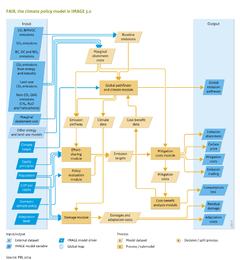Climate policy: Difference between revisions
Jump to navigation
Jump to search
No edit summary |
m (Text replace - "Scenario drivers" to "Drivers") |
||
| Line 1: | Line 1: | ||
{{ComponentTemplate2 | {{ComponentTemplate2 | ||
|IMAGEComponent= | |IMAGEComponent=Drivers; Emissions; Energy supply; Energy conversion; Energy supply and demand; Vegetation, hydrology and agriculture; Atmospheric composition and climate; | ||
|ExternalModel=MAGICC model; AD RICE model; TIMER model; POLES model; Enerdata Global Energy & CO2 Data; IIASA database; | |ExternalModel=MAGICC model; AD RICE model; TIMER model; POLES model; Enerdata Global Energy & CO2 Data; IIASA database; | ||
|KeyReference=Den Elzen et al., 2011a; Den Elzen et al., 2008; Hof et al., 2009; Van Vliet et al., 2009; | |KeyReference=Den Elzen et al., 2011a; Den Elzen et al., 2008; Hof et al., 2009; Van Vliet et al., 2009; | ||
Revision as of 17:50, 16 May 2014
| Component is implemented in: |
|
| Related IMAGE components |
| Models/Databases |
| Key publications |
| References |
Key policy issues
- What global greenhouse gas emissions pathways would meet the well below 2 °C climate target?
- What is the effect of effort-sharing approaches on regional and national emission reduction targets and on the cost of climate policies?
- What is the effect of the NDCs on achieving the long term 2 ºC target?
- What are the trade-offs between mitigation costs, adaptation costs, and climate change damage?
